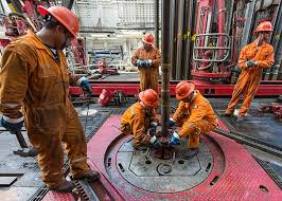like any process in the oil industry, oil well drilling has its own problems, and each problem has its own causes and remedy, you have to well-understand the drilling process to deal with drilling problems.
we can summarize the drilling problems as follows:
Oil Well Drilling Problems :
– Stuck pipe
– Lost circulation
– Borehole instabilities
– Mobile formation
– Undergauge hole
– Kicks and blowout
(1). Stuck Pipe/Pipe Sticking:
it is one of the most common problems in oil well drilling process.
Definition: When part of the drill pipe or collars are stuck in the hole
If pipe cannot be rotated or pulled and circulation is good, then pipe is probably wall stuck
Causes of pipe sticking:
a. Differential/wall sticking
b. Mechanical sticking
c. Key seating
(a). Differential/Wall Sticking
Definition: A pressure differential around the circumference of drill collars or pipe
Wall sticking is caused by:
– pipe is held by suction force resultant from overbalance hydrostatic pressure forcing filtrate into a permeable zone which leaves a thick mud cake on the wall of the hole.
– porous and permeable formation.
– motionless drill string.
(b). Mechanical Sticking
A drill pipe can be stuck mechanically when:
– Cuttings and sloughing formations pack off the annular space around the drill string (especially during a pump shutdown period).
– Drill through several layers of formation of different hardness.
– Junk dropped from surface.
– The drill string is run too fast until it hits a bridge, a tight spot or the hole bottom.
(c). Key Seating
Definition: a phenomenon happens at the dogleg where a new hole is created by drill string until the drill pipe is stuck to the wall.
– When it passes through a dogleg, it tries to straighten and thus, creating a lateral force which causes the drill pipe joint to dig into the formation at the dogleg bow.
– A key-seat can only be formed if the formation is really soft and the hanging weight below the dogleg is big enough to create a substantial lateral force.
– This problem can be identified when the drill string can be moved downwards but not upwards.
(2). Lost Circulation
– Definition: Partial or complete loss of drilling fluid during drilling, circulating or running casing.
– Occurred in almost every formation and at virtually all depths.
– Occurs when hydrostatic pressure of mud exceeds the breaking strength of the formation.
Type of Lost Circulation
Those types inherent in the formation:
– porous, permeable, and unconsolidated formations.
– cavernous or irregular formations.
– natural fractures in formations (faults, joints, fissures)
Those openings caused by poor drilling practices:
– induced fractures caused by high mud weights or pressure surges.
(3). Shale Problem/Borehole Instability
Shale:
sedimentary rock form by deposition and compaction of sediments, contain clays, silt water, quartz, feldspar, compact or unconsolidated rock depend on water content.
– Definition of shale problem/borehole instability:
a condition where the shale section containing bentonite or other hydratable clays which continually absorb water from the mud, expands, swell & slough into the hole.
– hole instability resulting from drilling shale sections.
– Other terms: sloughing shale, heaving shale, running shale.
Prevention of Sloughing Shale
– Use suitable mud system to inhibit hydration (high Ca & K content, OBM, oil-emulsion, …) to decrease the tendency of mud to hydrate water sensitive clays.
– Increase circulation rate for more rapid removal of particles.
– Increase mud density for greater wall support (Phyd > Pf).
– Decrease water loss of mud.
– Avoid fast trips or swabbing of the hole.
– Keep flow properties & annular velocity at such a level as to insure good hole cleaning.
(4). Mobile Formation
A salt or shale can squeeze into the oil well bore because it is being compressed by the overburden forces
– The deformation results in a decrease in the oil well bore size, causing problems running BHA’s, logging tools and casing and stuck pipe.
– A deformation occurs because the mud weight is not sufficient to prevent the formation squeezing into the oil well bore.
– Once broken, the hole will become enlarge.
Prevention Action
– Identify salt dome.
– Monitor mud chlorides and mud resistivity.
– Maintain sufficient mud weight.
– Select an appropriate mud system that will not aggravate the mobile formation.
– Plan frequent reaming/wiper trips particularly for this section of the hole.
– Slow trip speed before BHA enters the suspected area.
– Minimize the open hole exposure time of these formations.
(5). Undergauge Hole
– Drilling hard abrasive rock wears the drilling bit and the stabiliser gauge and results in a smaller than gauge hole.
– When a subsequent in-gauge bit is run, it encounters resistance due to the undergauge section of hole
– If the string is run into the hole quickly without reaming, the drilling bit can jam in the undergauge hole section
This mechanism normally occurs:
− After running a new drilling bit.
− After coring.
− When a PDC bit is run after a roller cone bit.
− When drilling abrasive formations.
(6). Kick and Blowout
– Blowout: Uncontrolled flow of formation fluids (gas, oil or water) from the wellbore.
– Kick and blowout can occur when hydrostatic pressure of mud is lower than the formation pressure.
Causes of Kick/Blowout:
1. Drilling into high pressure zones (abnormal pressure).
2. Swabbing when coming out of the hole.
3. Improper hole fill-up on trips.
4. Lost circulation during drilling or cementing.
it is to be mentioned that to prevent any blowout in the oil well you have to use the Blow-Out Preventers “BOPs”.
Resources:
1. Horizontal, Directional, and Multilateral Drilling – Richard Carden.
2. Fundamentals Of Petroleum Engineering / Drilling Operation – Mohd Fauzi Hamid/ Wan Rosli Wan Sulaiman.

